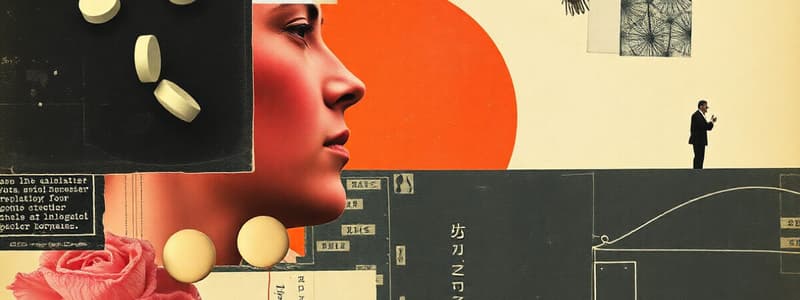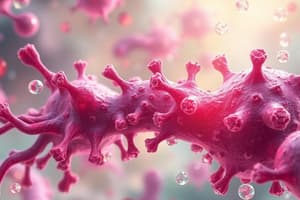Podcast
Questions and Answers
A patient taking diphenhydramine complains of dry mouth and constipation. Which receptor interaction is most likely responsible for these side effects?
A patient taking diphenhydramine complains of dry mouth and constipation. Which receptor interaction is most likely responsible for these side effects?
- Alpha-adrenergic receptor antagonism
- H1 receptor antagonism
- H2 receptor antagonism
- Muscarinic cholinergic receptor antagonism (correct)
Why are second-generation H1 antihistamines like loratadine less likely to cause sedation compared to first-generation antihistamines?
Why are second-generation H1 antihistamines like loratadine less likely to cause sedation compared to first-generation antihistamines?
- They are more rapidly metabolized by the liver.
- They do not readily enter the central nervous system (CNS). (correct)
- They have a higher affinity for H2 receptors.
- They stimulate the release of histamine.
A patient with seasonal allergies is looking for an antihistamine. Which medication is likely to be the MOST effective if taken before allergen exposure?
A patient with seasonal allergies is looking for an antihistamine. Which medication is likely to be the MOST effective if taken before allergen exposure?
- A mast cell stabilizer
- A corticosteroid nasal spray
- An H1-antihistamine (correct)
- A leukotriene antagonist
Sumatriptan is effective in treating migraine headaches because it acts as an agonist at which receptor?
Sumatriptan is effective in treating migraine headaches because it acts as an agonist at which receptor?
Losartan is prescribed for hypertension. What is its mechanism of action?
Losartan is prescribed for hypertension. What is its mechanism of action?
Which autacoid's synthesis is inhibited by aspirin, leading to its anti-inflammatory and analgesic effects?
Which autacoid's synthesis is inhibited by aspirin, leading to its anti-inflammatory and analgesic effects?
Montelukast is used in the treatment of asthma because it antagonizes the effects of which autacoid?
Montelukast is used in the treatment of asthma because it antagonizes the effects of which autacoid?
Which of the following NSAIDs is known to irreversibly inhibit cyclooxygenase (COX) enzymes?
Which of the following NSAIDs is known to irreversibly inhibit cyclooxygenase (COX) enzymes?
A patient is taking aspirin for its antiplatelet effects following a myocardial infarction. What is the mechanism by which aspirin reduces platelet aggregation?
A patient is taking aspirin for its antiplatelet effects following a myocardial infarction. What is the mechanism by which aspirin reduces platelet aggregation?
Why is aspirin generally avoided in children with viral infections like chickenpox or influenza?
Why is aspirin generally avoided in children with viral infections like chickenpox or influenza?
A patient with a history of gastric ulcers is prescribed an NSAID. Which of the following is the MOST appropriate choice to minimize the risk of further GI irritation?
A patient with a history of gastric ulcers is prescribed an NSAID. Which of the following is the MOST appropriate choice to minimize the risk of further GI irritation?
Which of the following distinguishes acetaminophen from aspirin?
Which of the following distinguishes acetaminophen from aspirin?
A patient reports experiencing tinnitus after taking high doses of aspirin. What is the MOST likely cause of this side effect?
A patient reports experiencing tinnitus after taking high doses of aspirin. What is the MOST likely cause of this side effect?
A patient reports experiencing migraines, what dietary advice might be useful?
A patient reports experiencing migraines, what dietary advice might be useful?
What is the primary mechanism by which triptans alleviate migraine pain?
What is the primary mechanism by which triptans alleviate migraine pain?
Which of the following is a nonpharmacologic treatment for migraines?
Which of the following is a nonpharmacologic treatment for migraines?
Which of the following is a specific drug for migraine treatment?
Which of the following is a specific drug for migraine treatment?
What characterizes the variable effectiveness of triptans among individuals for migraine treatment?
What characterizes the variable effectiveness of triptans among individuals for migraine treatment?
How do ergot alkaloids and triptans work to treat migraines?
How do ergot alkaloids and triptans work to treat migraines?
What is the therapeutic use of ergotamine and dihydroergotamine?
What is the therapeutic use of ergotamine and dihydroergotamine?
In migraine prophylaxis, what is the role of Flunarizine?
In migraine prophylaxis, what is the role of Flunarizine?
Among prophylactic medications used for migraines, which is typically considered to be the drug of choice?
Among prophylactic medications used for migraines, which is typically considered to be the drug of choice?
What is the general approach to migraine treatment for severe cases?
What is the general approach to migraine treatment for severe cases?
What is a common side effect experienced by patients taking Triptans?
What is a common side effect experienced by patients taking Triptans?
Which statement correctly differentiates opioid analgesics from analgesic antipyretics?
Which statement correctly differentiates opioid analgesics from analgesic antipyretics?
Compared to aspirin, what characterizes the potency for all pain relief?
Compared to aspirin, what characterizes the potency for all pain relief?
Which class of autacoids includes bradykinin and kallidin?
Which class of autacoids includes bradykinin and kallidin?
Which drug is a lipooxygenase inhibitor used in the treatment of leukotrienes?
Which drug is a lipooxygenase inhibitor used in the treatment of leukotrienes?
Which of the following is a serotonin agonist?
Which of the following is a serotonin agonist?
Which of the following is an analog of Prostaglandins?
Which of the following is an analog of Prostaglandins?
Which of the following drugs are AT1 blockers?
Which of the following drugs are AT1 blockers?
Patients using first-generation drugs experience multiple side effects due to cross-reactivity with muscarinic cholinergic and a-adrenergic receptors. Which of the following is NOT an effect of first-generation drugs:
Patients using first-generation drugs experience multiple side effects due to cross-reactivity with muscarinic cholinergic and a-adrenergic receptors. Which of the following is NOT an effect of first-generation drugs:
Which of the following statements is incorrect?
Which of the following statements is incorrect?
A patient with a known hypersensitivity to aspirin requires an analgesic and anti-inflammatory medication. Which of the following would be the MOST appropriate alternative, considering the patient's history?
A patient with a known hypersensitivity to aspirin requires an analgesic and anti-inflammatory medication. Which of the following would be the MOST appropriate alternative, considering the patient's history?
A researcher is investigating potential targets for novel migraine therapies. Based on the provided information, which of the following mechanisms would be MOST promising in alleviating migraine pain?
A researcher is investigating potential targets for novel migraine therapies. Based on the provided information, which of the following mechanisms would be MOST promising in alleviating migraine pain?
A patient experiencing frequent migraines is prescribed Propranolol for prophylactic treatment. What is the MOST likely reason for selecting Propranolol as a preventative measure?
A patient experiencing frequent migraines is prescribed Propranolol for prophylactic treatment. What is the MOST likely reason for selecting Propranolol as a preventative measure?
A patient taking a first-generation H1 antihistamine is advised to avoid driving or operating heavy machinery. What is the MOST likely reason for this advice?
A patient taking a first-generation H1 antihistamine is advised to avoid driving or operating heavy machinery. What is the MOST likely reason for this advice?
A patient is prescribed Montelukast as part of their asthma management. What is the primary mechanism of action by which Montelukast helps to control asthma symptoms?
A patient is prescribed Montelukast as part of their asthma management. What is the primary mechanism of action by which Montelukast helps to control asthma symptoms?
Flashcards
What are autacoids?
What are autacoids?
Autacoids are substances produced locally that exert their effects near their site of synthesis, acting on various receptors. Examples include histamine, serotonin, angiotensin, kinins, prostaglandins, and leukotrienes.
Where is histamine stored?
Where is histamine stored?
Histamine is stored in mast cells and basophils and acts on H1, H2, H3, and H4 receptors.
What are H1-receptor antagonists?
What are H1-receptor antagonists?
H1-receptor antagonists block H1 receptors and are divided into first-generation (e.g., diphenhydramine) and second-generation agents (e.g., loratadine).
Side effects of first-generation antihistamines?
Side effects of first-generation antihistamines?
Signup and view all the flashcards
Advantage of second-generation antihistamines?
Advantage of second-generation antihistamines?
Signup and view all the flashcards
When to take H1-antihistamines?
When to take H1-antihistamines?
Signup and view all the flashcards
Uses for H1-antihistamines?
Uses for H1-antihistamines?
Signup and view all the flashcards
What are eicosanoids?
What are eicosanoids?
Signup and view all the flashcards
How do NSAIDs work?
How do NSAIDs work?
Signup and view all the flashcards
Mechanism of analgesic antipyretics?
Mechanism of analgesic antipyretics?
Signup and view all the flashcards
How does aspirin work?
How does aspirin work?
Signup and view all the flashcards
What are aspirin's effects?
What are aspirin's effects?
Signup and view all the flashcards
Adverse effects of aspirin?
Adverse effects of aspirin?
Signup and view all the flashcards
How to reduce aspirin's gastric effects?
How to reduce aspirin's gastric effects?
Signup and view all the flashcards
When is aspirin's antiplatelet effect useful?
When is aspirin's antiplatelet effect useful?
Signup and view all the flashcards
Benefits of COX-2 inhibitors?
Benefits of COX-2 inhibitors?
Signup and view all the flashcards
Risks of COX-2 inhibitors?
Risks of COX-2 inhibitors?
Signup and view all the flashcards
Difference between COX inhibitors?
Difference between COX inhibitors?
Signup and view all the flashcards
Characteristics of aspirin?
Characteristics of aspirin?
Signup and view all the flashcards
Characteristics of paracetamol?
Characteristics of paracetamol?
Signup and view all the flashcards
Examples of NSAID derivatives?
Examples of NSAID derivatives?
Signup and view all the flashcards
Function of COX isoforms?
Function of COX isoforms?
Signup and view all the flashcards
Who gets migraines?
Who gets migraines?
Signup and view all the flashcards
Two main migraine types?
Two main migraine types?
Signup and view all the flashcards
What happens during a migraine?
What happens during a migraine?
Signup and view all the flashcards
Common migraine triggers?
Common migraine triggers?
Signup and view all the flashcards
Symptoms during migraine with aura?
Symptoms during migraine with aura?
Signup and view all the flashcards
How do ergot and triptans alleviate migraines?
How do ergot and triptans alleviate migraines?
Signup and view all the flashcards
Non-drug migraine treatments?
Non-drug migraine treatments?
Signup and view all the flashcards
What medications help migraines?
What medications help migraines?
Signup and view all the flashcards
What medicines are specific to migraines?
What medicines are specific to migraines?
Signup and view all the flashcards
What receptors do Triptans target?
What receptors do Triptans target?
Signup and view all the flashcards
Side Effects of Triptans?
Side Effects of Triptans?
Signup and view all the flashcards
How do Ergots Work??
How do Ergots Work??
Signup and view all the flashcards
What drug to use to treat migraine?
What drug to use to treat migraine?
Signup and view all the flashcards
Alternatives to Propranolol?
Alternatives to Propranolol?
Signup and view all the flashcards
How to treat Mild Cases of Migraine?
How to treat Mild Cases of Migraine?
Signup and view all the flashcards
How to treat severe symptoms of Migrane?
How to treat severe symptoms of Migrane?
Signup and view all the flashcards
Side effects of Triptans?
Side effects of Triptans?
Signup and view all the flashcards
Characteristics of Opioid Analgesics?
Characteristics of Opioid Analgesics?
Signup and view all the flashcards
Side Effects of Narcotic Analgesics?
Side Effects of Narcotic Analgesics?
Signup and view all the flashcards
How do Anti-pyretics Work?
How do Anti-pyretics Work?
Signup and view all the flashcards
Why Prophylaxis?
Why Prophylaxis?
Signup and view all the flashcards
Study Notes
- Autacoids are local hormones, including Histamine, Serotonin, Angiotensin, Kinins, Prostaglandins, and Leukotrienes.
- Agonists and antagonists exist for autacoids, and receptor types are specified in brackets.
- Histamine is stored in mast cells and basophils.
- Histamine acts on at least four receptor types: H1, H2, H3, and H4, with no current clinical applications.
Histamine (H1, H2)
- H1 blockers include Diphenhydramine, Chlorpheniramine, Promethazine, Cetirizine, and Loratadine.
- H2 blockers include Ranitidine, Famotidine, and Roxatidine.
- H1-receptor antagonists (antihistamines) are divided into first-generation and second-generation agents.
- First-generation drugs include Diphenhydramine and dimenhydrinate, Cyclizine, Meclizine, Chlorpheniramine and Cyproheptadine. First-generation drugs often have multiple side effects like sedation and anticholinergic symptoms due to cross-reactivity with muscarinic cholinergic and a-adrenergic receptors.
- Second-generation drugs include Loratidine, Fexofenadine, and Cetirizine. Second-generation H1-antihistamines (e.g., Loratadine (Claritin), Fexofenadine (Allegra), Desloratidine (Clarinex), Cetirizine (Zyrtec)) do not readily enter the CNS and are more specific for H1 receptors, leading to fever side effects.
- H1 antihistamines are competitive antagonists. Their effectiveness is best when administered before exposure to an allergen. H1 antihistamines are more effective against acute allergic reactions than chronic allergies.
- Clinical uses for H1 antihistamines include treatment of seasonal allergic rhinitis, acute urticaria, anxiety, insomnia, nausea, and Parkinson's disease.
- First-generation antihistamines cross the blood-brain barrier, acting centrally and peripherally, but second-generation do not.
- Diphenhydramine (Benadryl), promethazine (Phenergan), clemastine (Tavist), chlorpheniramine (chlor-trimetron), hydroxyzine (atarax, vistaril), and dimenhydrinate (Dramamine) are first-generation antihistamines.
- Fexofenadine (Allegra) which is terfenadine metabolite, Loratadine (Claritin) with a 24-hour duration, and Cetirizine (zyrtec) are second generation antihistamines.
- Terfenadine (seldane) and astemizole ( hismanal) have been withdrawn due to cardiac concerns.
- First-generation antihistamines cause high sedation and anti-cholinergic effects, while second-generation ones have either.
5-HT or Serotonin (5-HT1-7)
- Agonists include Sumatriptan, Buspirone, and Dexfenfluramine.
- Blockers include Cyproheptadine, Ketanserin, and Ondansetron.
Angiotensin (AT1, AT2)
- AT1 blockers include Losartan.
- ACE inhibitors include Captopril, Enalapril, and Ramipril.
Kinins (B1, B2)
- Kinins include Bradykinin and Kallidin.
- Antagonists are being developed.
Prostaglandins
- Analogs include Misoprostol, Dinoprostone, and Carboprost.
- Synthesis inhibitors include Aspirin, Indomethacin, and Paracetamol
- NSAIDs inhibit cyclooxygenase enzymes, reducing the synthesis of prostacyclin (PGI2), prostaglandins, and thromboxane (TXA2) but have no effect on lipoxygenase which synthesizes leukotrienes.
Leukotrienes
- Antagonists include Montelukast, Zafirlukast, and Pranlukast.
- Lipoxygenase inhibitors include Zileuton.
Eicosanoids
- Eicosanoids are a large group of autacoids that are widely distributed in the body.
- These are locally synthesized from arachidonic acid via de novo synthesis.
- Arachidonic acid is converted to HPETE by Lipoxygenase, which then turns into HETE and then Leukotrienes.
- Cyclooxygenase turns Arachidonic acid into Endoperoxides, then synthetases convert it to Prostacyclin (PGI2), Prostaglandins, and Thromboxanes (TXA2).
- Zileuton inhibits Leukotrienes production via LOX.
- Montelukast blocks Leukotrienes.
- LTB4 affects Chemotaxis, while LTC4, LTD4, and LTE4 cause Bronchoconstriction.
- Misoprostol is a PGE1 analog, displaying gastroprotective properties and maintaining ductus patency, in addition to vasodilation . Alprostadil is also PGE1.
- Dinoprostone is a PGE2 analog causing uterine contraction.
- Carboprost is a PGF2alpha analog causing uterine contraction and elevates uveoscleral outflow of aqueous humor.
- Ileoprost is a PGI2 analog causing vasodilation and anti-aggregation.
- Aspirin inhibits TXA2, causing vasodilation and aggregation.
Analgesic Antipyretics
- Most analgesic antipyretics reduce prostaglandin synthesis by inhibiting cyclooxygenase (COX).
- Aspirin (acetylsalicylic acid) acetylates and irreversibly inhibits COX-1 and COX-2.
- The COX-2 efficacy approximates conventional NSAIDs, reducing GI ulcerations compared to COX1, but there is not antithrombotic activity. Renal complications at least the same but there are cardiovascular complications.
- Aspirin's main therapeutic effects include:
- Mild analgesia comes from reduced prostaglandin synthesis blocking pain in sensory nerve endings.
- Antipyresis comes from reduced prostaglandin synthesis in the hypothalamic temperature control center.
- Anti-inflammatory effects come from reduced prostaglandins at inflammation sites (high doses).
- Aspirin side effects include:
- Gastric ulcerations and hemorrhaging: increased by ingesting ethanol, decreased by taking with food or misoprostol.
- Reduced platelet aggregation by inhibiting thromboxane A2 formation.
- Hypersensitivity reactions may be due to increased leukotrienes.
- Reduced renal uric acid secretion at low doses and reduced uric acid reabsorption (uricosuria) at high doses.
- Aspirin is best avoided in children due to Reye’s syndrome, involving a fatal hepatitis and cerebral edema, in children with chicken pox (varicella) or influenza viral infections
- NSAIDs block conversion of Arachidonic acid to PG2.
- Common NSAID adverse effects include upper GI (dyspepsia, erosions, anemia, ulcers) and renal issues (dysfunction, failure, high blood pressure, heart failure), plus antiplatelet actions that increases blood loss.
- Aspirin, at 2-3 g/day, inhibits PGI2 and TXA2, causing vasodilation and inhibiting platelet aggregation. Low-dose aspirin (50-325 mg) also inhibits TXA2.
Aspirin vs. Other NSAIDs
- Aspirin differs from other NSAIDs in kinetics, toxicity, and antiplatelet effects.
- Aspirin inhibits prostaglandins in the gastric mucosa, increasing HCl production and causing loss of protective action, leading to gastric irritation and potential peptic ulcers.
- Aspirin exists in a unionized form at the acidic pH of the stomach. It enters mucosal cells then becomes ionized at pH 7.1, where it will become stiff and indigestible.
- Arachidonic acid is converted into inflammatory PGs by COX-2 enzyme and PG2s regulation function in the stomach, kidney and intestinal function via COX-1 enzyme.
- Aspirin is an antipyretic drug. Long-term use of Aspirin can cause nephropathy or overdose.
- it increases the risk of bleeding, and decreases platelet aggregation and has high plasma protein binding.
- Aspirin leads to GI bleeding and respiratory issues and is contraindicated in peptic ulcer disease. It has anti-inflammatory properties and impacts the CNS and peripheral nervous system (CNS,peripheral).
- Acetaminophen is another type of antipyretic drug that has no effect on nephropathy, doesn't affect or impact platelet aggregation or bleeding risk. It does not cause GI bleeds or respiratory issues and is hepatotoxic, impacting only the CNS.
- Non-selective COX inhibitors inhibit both COX-1 (non-inducible) and COX-2 (inducible) enzymes, while selective COX-2 inhibitors only act on the COX-2 (inducible) enzyme.
- Both classes of drugs have equal analgesic and antipyretic effects.
- Nonselective COX inhibitors have more frequent gastric side effects, increased renal side effects, and increased decreased CVS but frequent hypersensitivity reactions. Selective COX-2 inhibitors have less frequent gastric side effects, frequent increased renal side effects, increased CVS and less frequent hypersensitivity reactions.
- Unlike aspirin, Paracetamol does not have anti platelet properties which is usually the antidote.
- Aspirin is contraindicated, particularly in children with viral infection, peptic ulcers, or sensitivity to asthma. Examples of propionic acid derivatives include which are NSAIDS, and ibuprofen (Indomethacin) is an indol derivative.
Migraine
- Migraines are more prevalent in women than in men and often run in families. There are two main types:
- Migraines preceded by an aura.
- Migraines without aura, which account for 85% of cases, preceded by fatigue and irritability. Migraineurs can have visual symptoms such as flickering lights, spots, or loss of vision with Sensory symptoms include needles or numbness. Migraines can present other neurological symptoms such as speech problems.
- Trigeminal nerve (CN V) activation, leading to neuropeptide release (VIP, Sub P, CGRP), vasodilation, plasma protein extravasation, and mast cell degranulation activates nociceptors.
- Migraine triggers include diet, changes in sleep patterns, fluctuation of estrogen, increased stress and dietary sources such as aged cheese and chocolate.
- Pharmacological treatments for Migraines with ergots and triptans decrease neuropeptide release and cause direct vasoconstriction.
- Nonpharmacologic treatments include avoiding triggers, having regular sleeping habits, and retiring to darkened rooms.
- The drugs for treatment and side effects include NSAIDs, antiemetics, D2 antagonists (Chlorpromazine, Prochlorperazine, Metoclopramide)
- Specific treatments are drugs agonists at 5-HT1D receptors that cause vasodilation and release of calcitonin gene-related peptide at the trigeminal nerve, along with opoids (Rescue medication), such as Triptan Zolmitriptan tablets are used when other drugs do not achieve the desired response. Opioids can also be used via (Intranasally) and (Parenteral route).
- Specific triptans exhibit variable individual responses, variant absorption, and variant protein binding capacity as one or more drugs are needed for successful pain relief.
- Fast-acting medications are Rizatriptan 10mg tablets and Eletriptan 40mg tablets. Slow acting are Sumatriptan tablets and Almotriptan Film-coated Tablets which are better tolerated.
- Agonists at 5-HT 1D receptors (serotonin receptors) on the small peripheral nerves innervating intracranial vasculature are used for the TOC - acute attacks of migraine. Side effects include vasoconstriction & nausea due to ergot alkaloids > triptans).
Ergots for Acute Migraine
- Acute migraine treatment with Ergots act as agonists at 5-HT 1B & 5-HT 1D receptors, diminishing release of neuropeptides & vasoconstriction. It's also a partial agonists @ alpha-1 receptors, causing vasoconstriction, and can be used IV, IM, SC, & intranasal.
- Ergotamine & dihydroergotamine (Derivative of ergotamine) is used for acute attacks of migraine, It is indicated when headaches occur greater than or equal to 2 times a month and severe headaches & is complicated. It acts similarly to triptans and has used for IV/ intranasal route.
Migraine Prophylaxis
- Prophylaxis includes Propranolol, and beta blockers. It also includes Calcium channel blocker Flunarizine and Ergot alkaloid Methysergide Drugs used in prophylaxis Flunarizine, Cyproheptadine, Clonidine. Dr.G.Bhanu Prakash, Pizotifen, Release of Gabapentine, Valproate, Nortriptyline, and is often a drug of choice.
- Treatment for Mild cases are simple analgesics/NSAIDs or their combinations (± antiemetic). Treatment for Moderate cases are NSAIDs combinations/ triptan/ergot alkaloids (+ antiemetic). For Severe cases are Triptan/ergot alkaloids (+antiemetic + prophylaxis and Amitriptyline/other tricyclic antidepressants Flu/ Ca22 blocker and valproate/topiramate
Triptans Side Effects
- Triptans can cause Side effects such as fluctuations in Blood pressure, Flushing, heightened Sweating and pain and Pressure in chest, neck, throat & jaw.
- Opioids are powerful pain relievers often used for severe pain but come with a higher risk of side effects and dependence. Analgesic antipyretics, on the other hand, are used for both pain relief and fever reductionand are generally safer for mild to moderate pain.
- Narcotic analgesics (morphine), act potent in all pain types, except itching and have central action opioid receptors and cause Euphoria-drowsiness with Long term use leading to tolerance and dependence. Antipyretic analgesics (Aspirin) is Less potent, works on musculoskeletal pain and is anti-inflammatory working on the Thalamus and periphery, Lowering elevated body temperature to normal NNNNNNNNNNoooooooooooooo
Studying That Suits You
Use AI to generate personalized quizzes and flashcards to suit your learning preferences.






